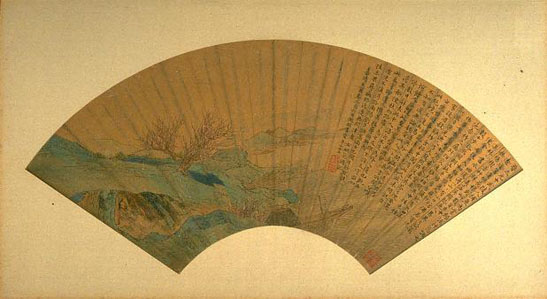Inscriptions on Paintings
CASE 1: Women and Arts in the 13th Century
One of the distinctive characteristics of Chinese painting is the use of inscriptions and seals as part of the painting itself. Scholar painters and literati critics treated the painting as an expression of the artist’s feelings and views. Therefore, literati painters developed this practice as a means of expressing more fully their views on art and society, as well as any other topics.
Below is an example of an inscription on a fan painting. The calligraphy on the upper right is the inscription.
Artist: Qiu Ying
Title: Peach Blossom Spring
Date: 1542
Period: Ming Dynasty (1368–1644 AD)
Medium: Fan album leaf, ink and color on gold paper
Location: University of Michigan Museum of Art
Inscription: By Wen Zhengming (upper right)
(Writing of T’ao Ch’ien’s “Peach Blossom Spring”): During the reign-period T’ai-yüan (326–97) of the Chin dynasty there lived in Wu-ling a certain fisherman. One day, as he followed the course of a stream, he became unconscious of the distance he had traveled. All at once he came upon a grove of blossoming peach trees which lined either bank for hundreds of paces. No tree of any other kind stood amongst them, but there were fragrant flowers, delicate and lovely to the eye, and the air was filled with drifting peach bloom.
The fisherman, marveling, passed on to discover where the grove would end. It ended at a spring; and then there came a hill. In the side of the hill was a small opening which seemed to promise a gleam of light. The fisherman left his boat and entered the opening. It was almost too cramped at first to afford him passage; but when he had taken a few dozen steps he emerged into the open light of day. He faced a spread of level land. Imposing buildings stood among rich fields and pleasant ponds all set with mulberry and willow. Linking paths led everywhere, and the fowls and dogs of one farm could be heard from the next. People were coming and going and working in the fields. Both the men and the women dressed in exactly the same manner as people outside; white-haired elders and tufted children alike were cheerful and contented. Some, noticing the fisherman, started in great surprise and asked him where he had come from. He told them his story. They then invited him to their home, where they set out wine and killed chickens for a feast.
When news of his coming spread through the village everyone came in to question him. For their part they told him how their forefathers, fleeing from the troubles of the age of Ch’in, had come with their wives and neighbors to this isolated place, never to leave it. From that time on they had been cut off from the outside world. They asked what age was this: they had never even heard of the Han, let alone its successors the Wei and the Chin. The fisherman answered each of their questions in full, and they sighed and wondered at what he had to tell. The rest all invited him to their homes in turn, and in each house food and wine were set before him. It was only after a stay of several days that he took his leave.
“Do not speak of us to the people outside,” they said. But when he had regained his boat and was retracing his original route, he marked it at point after point; and on reaching the prefecture he sought audience of the prefect and told him all of these things. The prefect immediately dispatched officers to go back with the fisherman. He hunted for the marks he had made, but grew confused and never found his way again.
The learned and virtuous hermit Liu Tzu-chi heard the story and went off elated to find the place. But he had no success, and died at length of a sickness. Since that time there have been no further “seekers of the ford.” To the right is the “Peach Blossom Spring.” 1542, spring, third month, sixth day. Written by Cheng-ming at the age of 73.
*Translated by Cyril Birch in his Anthology of Chinese Literature: From Early Times to the Fourteenth Century (New York: Grove Press, 1965), p. 167–8.
Seal of Wen Zhengming following the long inscription: Zhengming.
Additional seals: One unidentified seal at lower right corner: “Lang huan xian-guan cang-shan;” one almost illegible seal at lower left corner: “Qiu Ying,” which was identified by James Robinson and therefore attributed to Qiu Ying.
Marshall P. S. Wu. The Orchid Pavilion Gathering: Chinese Painting from the University of Michigan Museum of Art (Ann Arbor, MI: Regents of the University of Michigan), p. 66.


